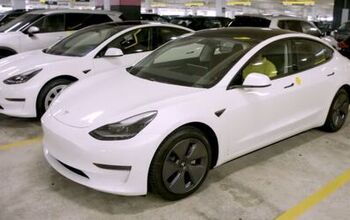The Great Hybrid Showdown: Chevrolet Volt Vs. Toyota Prius

The great hybrid showdown is coming. GM Car Czar Bob Lutz has thrown down the gauntlet: “We are headed for the OK Corral.” In fact, GM has staked its reputation on the Volt, intending to “leapfrog the Prius” and evoking America’s Apollo moon-shot program. Meanwhile, Toyota continues its domination of the alt power mindspace, finalizing their third generation Prius. While we prepare for the clash of the hybrids, let’s take a closer look at the contenders…
In the serial-hybrid corner: the Chevrolet Volt. Actually, GM prefers to call its gas -electric plug-in an “extended-range electric vehicle” or E-REV.
The Volt will feature a rechargeable 16kw lithium-ion battery pack. Its 120kw/160hp electric motor provides the motive power. A 53kw generator driven by an efficiency-optimized (non-E85) three-cylinder gasoline engine kicks-in when the batteries are depleted to a 30 percent state of charge (SOC). The Volt’s generator will then cycle as needed to keep the batteries within a targeted SOC range. Fuel economy– after initial charge depletion– is a projected 50mpg.
The Volt’s target price started at $30k. More recently, GM’s Car Czar declared that the Volt would sell for about $48k. The winner of TTAC’s annual Bob Lutz award reckons $40k might be possible “without making any profit.” For comparison purposes, we’ll assume an MSRP $44k.
GM has confirmed that the Volt’s first year production run will be limited to 10k units. After de-bugging, the number will rise to 100k and possibly beyond– depending on demand, how large a financial loss GM is willing to accept and for how long.
Even if the Volt’s batteries perform to specifications, GM’s initial promise of a forty-mile EV range has evaporated. GM now says continuous highway-speed driving will deplete the E-REV’s battery in “closer to 32 miles.” And that’s probably at the low end of typical highway speeds (as per the EPA highway cycle). A brisker freeway run, elevation gains, extreme temperatures and the use of heater, A/C and other electrical peripherals will all take their toll on the Volt’s range. It could easily descend into the twenties or… less.
Toyota will introduce their gen3 2010 Prius in January 2009. It will use a refined version of Toyota’s parallel Hybrid-Synergy drive (HSD), whereby electric and mechanically-transferred gasoline-engine propulsion are used individually as well as in various blended forms for propulsion.
Toyota has clearly stated goals for the gen3 Prius: reduced HSD-specific costs, weight reductions and most importantly, a targeted gain in efficiency of 15-20 percent. This should result in combined EPA mileage numbers of 53 – 55mpg (2008: 46mpg). Since average user mileage for gen2 Prius runs 42-44mpg, gen3 Prius should deliver real world mileage of 50+mpg.
The new Prius will have a more powerful electric motor and increased battery capacity, extending its limited EV-only range. Other refinements: improved aerodynamics, further efficiency gains in the Atkinson-cycle gas engine; and improved regenerative braking and hybrid system control.
For the first two years of production, Toyota will stick with the tried-and-proven NiMH batteries. In 2010, li-ion cells will go into volume production at Toyota’s battery supplier Panasonic. With the higher energy density of the li-ion pack, it’s safe to assume that the EV-only range of the base Prius will increase, perhaps double. This should further increase fuel efficiency, possibly to about 55mpg.
Additionally, there will be a plug-in Prius. Fleet tests start in 2010. If all goes well, volume production will begin the following year. Early versions will have a NiMH pack that will provide an EV range of about seven miles and an EV top speed of 62mph. When the definitive li-ion plug-in Prius arrives, its EV range could be some twenty miles.
Toyota has announced a 60 percent production increase for the gen3 Prius– from 280k units in 2007 to 450k in 2009 (worldwide). The car’s average transaction price should stay level, or possibly contract further. We’ll assume $22k for our comparisons. An educated guess at the price for the plug-in version: $30k.
Our comparison will encompass three primary criteria: owner economics, environmental benefits and “green cachet” (to both owner and manufacturer).
Hypothetical economic scenario one: six weekly round trips of 35 miles each. In this example, the Volt would never need a drop of gasoline (except for the occasional auto-programmed runs to cycle fuel and oil). If we inflation-adjust today’s electric rates, a recharge will average about one dollar. Annual “fuel” cost: $312.
A Prius would take 220 gallons of gas @ 50mpg to cover the same 11k miles. Assuming $4/gallon in 2011, annual fuel cost is $880. The Volt’s $22k purchase premium over the Prius would take 39 years to amortize. A $40k “subsidized” Volt would take a mere 32 years. These calculations don’t include interest, either on the higher purchase price of the Volt, or on the money saved (opportunity cost).
Even if we slash electric rates in half, to 50 cents a charge, it would still take over thirty years to amortize the Volt’s higher purchase price. Comparing the Volt to the plug-in Prius is even less favorable to the Chevy: it would take 58 years to recoup the Volt’s $14k price differential.
Scenario Two: a short daily commute of twelve miles round trip (3744 miles annually) and an additional 3744 miles on long-distance trips @ 50mpg. The Volt’s total annual combined “fuel” cost is $400. The regular Prius’ annual fuel cost is $600. It would take 110 years to amortize the Volt. And the plug-in Prius, which can make the short commute all-electrically, trumps the Volt altogether, with fuel costs of $372. And it costs $14k less.
Scenario three: a long-distance commute with a daily round trip of seventy miles, plus 6k of long-distance miles (23.5k annual total). The Volt’s fuel costs run $1465 annually. The Prius’ are $1880, resulting in a 53 year payback for the Volt. And the plug-in Prius accomplishes the task with a $1488 fuel bill, only $23 more than the Volt (609 year payback!).
Scenario two and three point out the Volt’s two biggest weaknesses: its expensive and heavy battery pack becomes increasingly less cost-effective when its maximum range is not fully utilized (Scenario 2). And its serial hybrid drive is no more efficient (if anything, somewhat less so) at continuous highway speed than Toyota’s HSD (Scenario 3). The Volt’s efficiency losses of generation, conversion, battery storage, re-conversion to AC, and electric drive-motor losses equal or exceed the minimal efficiency loss of the Prius’ mechanical transmission.
All of the above scenarios point out the glaring economic disadvantage of the Volt due to its high cost. Its price would have to come down to $28k to justify a (barely) reasonable ten-year payback in the Volt-optimal Scenario One, and substantially less for the others.
Plug-ins clearly are not about the economics, because even the plug-in Prius (@$30k) has a payback of between 24 and 35 years versus the regular $22k Prius in the above three scenarios.
A comparison and analysis of the environmental-social benefits of hybrids versus plug-ins quickly becomes complicated, due to the variable sources of electricity (high or low carbon content). But the over-arching issue of total (cumulative) gas savings offers some simpler answers.
Aggregate gas savings are much more readily and cost-effectively accomplished through large numbers of conventional hybrids (Prius) than small numbers of somewhat more efficient but much more costly plug-ins. Toyota’s 2009 production of about 500k Priora (@ 50mpg) will save 120 million gallons of gasoline compared to a like number of 25mpg conventional mid-sized sedans, at little or no incremental cost.
But 100k Volts produced per year at an adjusted/equivalent 100mpg save only 36m gallons over the 25mpg car, and a mere 120k gallons over a like number of Priora; in both cases at an incremental cost of some $22 million. Smaller gains in economy spread over a large number of vehicles always delivers a much greater cumulative savings than a small number of super-high efficiency cars.
Even if plug-in hybrids are driven on cycles that maximize their EV range, greenhouse gas (GHG) reductions are surprisingly modest, and highly dependent on the carbon-intensity of the electric source. A new study by Carnegie Mellon shows that unless plug-ins are matched to low-carbon electric sources, GHG emission gains (compared to conventional hybrids) are minimal, and negative in some circumstances.
These and a number of other objective criteria clearly suggest that finite public (and private) resources are best spent in the expansion of existing high-efficiency hybrids, like the Prius and the upcoming new lower-cost Honda hybrid sedan, rather than exotic and expensive limited-production vehicles like the Volt– at least until li-ion battery prices drop dramatically. Meanwhile, GM does not have a Prius-like hybrid to sell, or in the planning stages.
Objective criteria are not the main reason for the GM’s “moon shot” investment in the Volt. When it comes to “green bragging rights,” the Volt may well out-score the Prius– at least for GM and its eager cadre of early adopters. If the final styling is both distinctive and has “it” (like the concept), if the Hollywood crowd adopts it as their newest green baby, if the words “plug-in” or “E-REV” supersede plain-old “hybrid” in green-speak, the Volt could become THE car of the green-tinged moment.
But let’s be clear: both eco-consciousness and the Toyota Prius have moved beyond fads, into fully blown trends. (Federal legislation sealed the deal.) The Chevy Volt and the Toyota Prius must ultimately compete in the automotive mainstream, where the Volt is at a supreme price disadvantage. Unless GM is willing to heavily subsidize the Volt for many years, no matter how good it is, the Prius will kick its ass.

More by Paul Niedermeyer
Latest Car Reviews
Read moreLatest Product Reviews
Read moreRecent Comments
- Jalop1991 the Honda eeny? WTF?Drugs are bad, mmmmkay?
- ToolGuy These would have sold better with a more prominent grille design.Source: BMW
- Cprescott Not legal. Executive branch cannot fund jack. This is Congressional authority.
- FreedMike I'm sure it's a nice enough car, but dear Lord, are these ugly, and it's a lot worse in light colors.
- Fred If the guy behind me had auto braking maybe he wouldn't have rear ended me and totaled my car. Even with insurance it would of saved me $10g and I'd still have my safe driving discount.


































Comments
Join the conversation
[...] to be better? Obviously, GM has collected quite a few fans of the new Chevy Volt, but according to the truth about cars, the Prius will still come out on [...]
[...] scientific, less comprehensive (and, by virtue of the passage of time, less speculative) version of a piece my father wrote in 2008, comparing the then-undelivered Volt with the also unlaunched 3rd gen Prius and Plug-In Prius. [...]